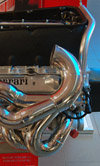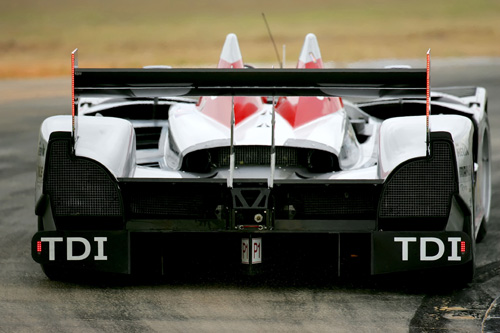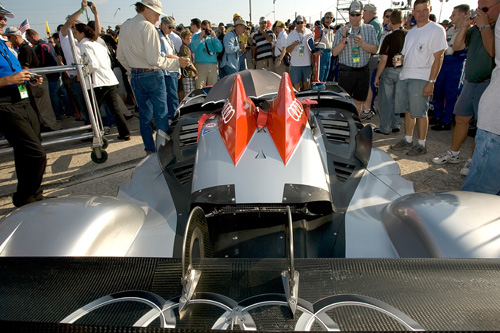Letting off gas
 In the first eight years of the twenty first century (with the single exception of 2003), the honours in the 24 Hours of Le Mans have undoubtedly belonged to the team from Ingolstadt. Since its introduction in 2006, the last three years have been the sole domain of the diesel-powered Audi R10 Tdi, but its predecessor, the petrol-powered R8, took top honours from 2000 to 2005 (with the exception of Bentley’s Audi-powered win in 2003).It was perhaps inevitable then that the ACO would change the rules in the face of such domination and for the 2009 season the organising body stipulated a 40 cm reduction in the width of the rear wing.
In the first eight years of the twenty first century (with the single exception of 2003), the honours in the 24 Hours of Le Mans have undoubtedly belonged to the team from Ingolstadt. Since its introduction in 2006, the last three years have been the sole domain of the diesel-powered Audi R10 Tdi, but its predecessor, the petrol-powered R8, took top honours from 2000 to 2005 (with the exception of Bentley’s Audi-powered win in 2003).It was perhaps inevitable then that the ACO would change the rules in the face of such domination and for the 2009 season the organising body stipulated a 40 cm reduction in the width of the rear wing.
As a result of this development and in reaction to Peugeot’s more adventurous 908 design, Audi began work in autumn 2007 on their R10 replacement, the R15, which debuted at the Sebring 12 Hour earlier this year.New this year is the R15’s powerful V10 Tdi engine which is both smaller and lighter than the 12-cylinder engine it replaces. This is the basis of an improved car package, which takes a more radical approach to LM P1 aerodynamics. Fundamental differences can be seen both front and rear and whereas the two exhaust pipes of the R10 exited from the back of the car, the R15 exhausts exit through the upper rear bodywork, echoing the current trend in Formula One.Ulrich Baretzky, Head of Engine Development at Audi Sport said, “The exhaust [shape] is determined by the total package and the aerodynamics.” It seems that due to reduced space at the rear of the car (in spite of the more compact engine), rerouting the exhausts became expedient and in any case Audi also claims that by rerouting them in this way, the gases exiting the pipes are channelled through the rear wing set-up, which in effect has an additional aerodynamic function. The gases do speed up the air flow above the bodywork as Wolfgang Appel, Head of Vehicle technology, Audi Sport confirms: “Because of the higher flow velocity (energy) the rear-deck-gurney is impinged in a better way and so [it is] more efficient.”

This comprehensive replumbing has enabled the Audi engineers to substantially reduce the weight of the exhaust system by shortening the outlet pipes, which are now made from titanium, instead of stainless steel. Although the engine is the same capacity, that is 5.5-litres, it has two less cylinders and therefore two less outlet pipes from the engine. Asked if the exhaust system from the engine to the turbochargers is the same as the R10, Baretzky commented, “Lets say in principle, yes.”Although Audi is remaining tight-lipped as regards the exhaust outlet diameter, Baretzky explained that this was determined by two main factors namely, backpressure versus mass flow and, the geometry of the diesel particulate filter.However, some of the biggest changes to the R15’s exhaust system are to be found in the particulate filters themselves. Over the past three years Audi has worked closely with Dow Automotive to develop their advanced lightweight, compact ceramic technology particulate filters, with proven results. Baretzky again: “This was the only company that could offer us very advanced ceramic technology with lightweight, high efficiency [particulate filters] and a very low backpressure. It is difficult to find all these factors combined in one product, and Dow wanted to prove their new technology in the hardest environment they could imagine, and that is Le Mans.”The Audi/Dow particulate filter works in such a way that the gas enters on the engine side, while the opposite side is closed, which means this is not a so-called ‘open’ system. Some manufacturers provide an open particulate filter, but this does not offer a true total purification of the gas, up to 100 percent, as there will always be particulates that escape through the open system. In the Dow system, 100 percent of the particulates are trapped in the filter as the exhaust gas has to pass through the extremely thin ceramic walls within the particulate filter. “The porosity in these walls of the particulate filter defines on the one hand the backpressure, and on the other hand the percentage of purification which in the end, is 100 percent. And this is the technology that is the secret of this particulate filter,” Baretzky explained.

The key technology that Dow has developed in the last few years has made this system not only stable but very lightweight and very effective in terms of cleaning the exhaust gases. “You can come and wipe inside our exhaust after the race at Le Mans once it has cooled down, to see how clean it is. We do this regularly every year, its very impressive,” Baretzky added.